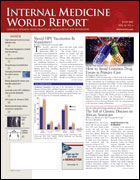Publication
Article
Internal Medicine World Report
Aging Processes Impair Ability to Deal with Cold
Author(s):
J Appl Physiol
Specific characteristics have been identified that have a significant effect on how young and old people respond to cold temperatures and could explain why the elderly are more susceptible to hypothermia, an especially deadly condition in this population, a new study reports (. 2006;101:1607-1615).
Nearly half of all elderly patients who become hypothermic die. In contrast, children rarely succumb to hypothermia, and young adults are less susceptible than the elderly.
This study, which included 42 younger (age, 18-30 years) and 46 older (65-89 years) men and women, examined the relative influence of physical characteristics thought to play a role in how the body's core temperature and tissue insulation react to cold. The 10 characteristics reviewed were age, gender, weight, body surface area, body surface area-to-mass ratio, sum of skin folds, percent body fat, appendicular skeletal muscle mass, and serum concentrations of total triiodothyronine (T3) and total thyroxine.
None of the participants smoked or took medications that could alter their cardiovascular or thermoregulatory responses to cool temperatures. All underwent standardized medical screening and physical examinations, at which time each of the 10 characteristics was measured or calculated. Next, they entered a controlled environmental chamber with a baseline temperature that remained stable before decreasing at a rate of 0.2°C per minute for 20 minutes and 0.05°C per minute thereafter to approximate mild cold exposure. The participants were removed from the chamber when visible, sustained shivering occurred.
Multiple regression analyses were performed to determine the predictors of body temperature and tissue insulation, and standardized regression analysis coefficients were analyzed to determine the relative influence of each of the 10 candidate variables.
In young participants, percent body fat and T3 hormone level were the factors that explained most of the variance in body temperature response to cold. Among older participants, percent body fat and/or skeletal muscle mass were the main determinants.
P
The sum of skin folds was responsible for 67% ( <.01) of body temperature variance in young participants compared with only 2% of body temperature variation in older participants. Unexplained variance of body temperature in response to cold was considerably less in younger (14%-42%) than in older individuals (59%-72%).
These results suggest that the well-known changes in body composition with aging have an impact on the body's response to cold temperatures as we grow older. Physical characteristics that are important in young people become less important with aging, and previously insignificant physical characteristics in young people become more important with age, the investigators note.






